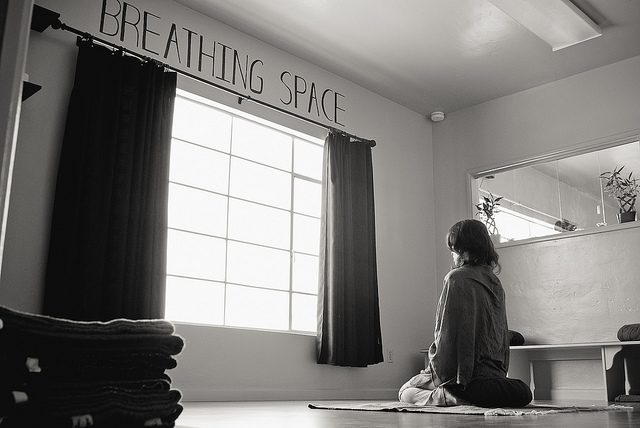I remember well the first Yoga class I attended. It was at a YMCA and I went for the purpose of staying in shape and increasing flexibility. It all started out innocently enough…until pranayama.
I could feel my woo-woo sensors lighting up as the teacher told us to make sounds like a snake on the exhale. Then there was a strange practice of closing alternate nostrils. For this Southern girl, it would be a while before she returned to class.
Fast forward a few years and an intense Sivananda Yoga Teacher Training in India, I fell in love with pranayama. The experience of daily anuloma viloma and kapalabhati practices gave me the sense of feeling cleansed from top to bottom. I felt clear, calm, energized, and focused. Meditation after these practices was ideal as my mind was already settled.
I continued these practices on my own, but with a fresh memory of my first exposure, I only shared breathwork with students who seemed ready. Some lineages restrict pranayama to advanced Yoga practitioners but, from my training, it can be completely safe if the student is ready, and after considering any contraindications.
Yoga teachers learn that pranayama is one of the eight limbs of yoga in Patanjali’s Yoga Sutras—a foundation of classical yoga philosophy. Patanjali defined yoga as “the restraint of the modifications of the mind-stuff.” As such, it is easy to see why pranayama is an essential aspect of yoga yet, the plethora of available breathing practices is often reduced to simple breath awareness during asana (pose).
Because of the amazing effects I’ve felt and seen in my students, and the scarcity with which it is taught in some other lineages, I began looking into recent pranayama researches. These ancient practices are receiving well-deserved recognition through research showing the effective clinical application for the treatment of numerous conditions. I found 34 studies in peer-reviewed journals, from 2009 to 2013. Some of the more interesting studies are highlighted here in hopes of encouraging fellow yoga teachers and students to incorporate pranayama into their practice.
Much of what pranayama does is due to it’s affect on the autonomic nervous system (ANS). The ANS controls physical processes such as digestion, respiration, heart rate, immune function and excretion. It has two branches known as the sympathetic nervous system (fight-or-flight response) and the parasympathetic nervous system (rest and digest). Because respiration is a system within the ANS over which we have conscious control, yogic breathing practices have been successfully applied to balance other ANS functions.
Pranayama’s influence on:
… the cardiovascular system:
In 2009, a study of 39 people who performed a five-minute breathing practice (inhaling for four seconds, exhaling for six) found that it significantly lowered their systolic and diastolic pressure and slightly lowered their heart rate. However, the same breathing practice done after taking a parasympathetic blocker drug showed no change in these parameters. The breathing practice was found to improve the ANS though activation of the parasympathetic system (rest and digest). In addition, participants reported feeling calm, further supporting parasympathetic stimulation. [1]
Ninety people with hypertension tested the effect of alternate nostril breathing, breath awareness, or quietly reading and found that alternate nostril breathing reduced blood pressure while improving performance in a manual dexterity test and fine motor speed. Thus alternate nostril breathing was found to be an appropriate therapy for helping people with hypertension perform focused tasks without raising their blood pressure. [2]
… brain wave activity:
Brahmari, a breathing practice involving specific placement of the fingers on the face to close the eyes and mouth while producing a buzzing sound through the nose, was studied to determine its effect on brain wave activity.
Eight participants did brahmari for five to 10 minutes twice a day for four months. The research found that Brahmari increased theta brain wave activity, which is normally exhibited during deep meditation. It also induced feelings of bliss “where thoughts are absent, but consciousness remains.” Thus the study determined that Brahmari is an effective therapy for stress. [3]
… diabetes:
A study involving 123 participants with type 2 diabetes was conducted to determine the effect of diaphragmatic breathing on their condition. The breath practice was done between 15 and 20 minutes daily, twice a day, four days a week, for three months. Diaphragmatic breathing was found to significantly lower oxidative stress by reducing body mass index, waist-hip ratio, fasting and post prandial plasma glucose, glycated hemoglobin, and improving antioxidant levels (malondialdehyde, superoxide dismutase, glutathione and vitamin C). This is important because oxidative stress associated with hyperglycemia can lead to diabetes mellitus and conditions like atherosclerosis and neuropathy. Therefore, the authors of the study determined that diaphragmatic breathing could significantly benefit those with diabetes. [4]
… gastroesophageal reflux disease (GERD):
A study involving 19 people with non-erosive GERD found that relaxed abdominal breathing for 30 minutes daily significantly affected their health and well-being. After four weeks, their stomach acidity had significantly decreased and their quality of life scores improved. After nine months, there was also a noteworthy decrease in usage of their on-demand proton pump inhibitor (the standard acid-suppressant drug) to less than one-third. There was no improvement in any of these variables in the control group receiving no intervention. [5]
… oxidative stress of athletes:
Oxidative stress is the burden placed on the body by free radicals due to metabolism and environmental toxins (air, food, water, etc.) and can contribute to accelerated ageing and disease.
A study was conducted on extreme athletes performing exhaustive exercise as this form of exercise causes oxidative stress. The study tested the effect of one-hour of diaphragmatic breathing post-exercise. The research found that diaphragmatic breathing significantly reduced oxidative stress. It also lowered cortisol levels and reactive oxygen metabolites and improved antioxidant levels including melatonin. As a result, diaphragmatic breathing was determined to be an appropriate recovery technique to protect athletes from the adverse effects of exercise-induced oxidative stress. [6]
Postprandial (occurring after a meal) hyperglycaemia can cause oxidative stress by increasing free-radical production and lowering antioxidant levels. A study involving athletes found that diaphragmatic breathing after a meal significantly reduced the heart rate, increased insulin, reduced glycaemia, and reduced free-radical production. For athletes, oxidative stress caused by a high carbohydrate diet may affect performance and cause fatigue, muscle damage, and lower immune function. Therefore, Diaphragmatic Breathing may be a useful therapy to protect athletes from oxidative stress. [7]
…pain:
A study involving 16 participants tested the effect of two kinds of deep, slow-breathing (DSB) on pain perception—attentive DSB vs. relaxing DSB. Attentive DSB allowed participants to modify their breathing using a feedback monitor, requiring their constant attention. Participants doing relaxing DSB maintained their breathing at seven cycles per minute, but did so independently, without the use of a feedback monitor. The study found a significant increase of pain thresholds after relaxing DSB, creating less sensitivity to their pain. In contrast, the attentive DSB therapy had no effect on their pain thresholds. [8]
…preterm labor:
A study of 60 women hospitalized for preterm labor found that abdominal breathing performed three times/day for three days provided compelling positive benefits for their physical and emotional well-being. Abdominal Breathing notably lowered their anxiety and stress levels and significantly lowered the dosage of tocolytics (labor suppressants). In contrast, the control group with no breathing intervention continued to see an increase in all these variables. [9]
Though continued research is needed, these studies offer scientific evidence of yoga’s ancient practice of pranayama as a valid therapy to heal humans from all sorts of conditions and to improve one’s health and well-being.
I hope these studies give you the confidence to begin integrating more pranayama practices into your life and the lives of your students.
“Breath is central to Yoga because it is central to life.” ~ T. Krishnamacharya
~
References:
1. Pramanik T, Sharma HO, Mishra S, Mishra A, Prajapati R, Singh S. Immediate effect of slow pace bhastrika pranayama on blood pressure and heart rate. J Altern Complement Med. 2009 Mar;15(3):293-5
2. Telles S, Yadav A, Kumar N, Sharma S, Visweshwaraiah NK, Balkrishna A. Blood pressure and Purdue pegboard scores in individuals with hypertension after alternate nostril breathing, breath awareness, and no intervention. Med Sci Monit. 2013 Jan 21;19:61-6
3. Vialatte FB, Bakardjian H, Prasad R, Cichocki A. EEG paroxysmal gamma waves during Bhramari Pranayama: a yoga breathing technique. Conscious Cogn. 2009 Dec;18(4):977-88
4. Hegde SV, Adhikari P, Subbalakshmi NK, Nandini M, Rao GM, D’Souza V. Diaphragmatic breathing exercise as a therapeutic intervention for control of oxidative stress in type 2 diabetes mellitus. Complement Ther Clin Pract. 2012 Aug;18(3):151-3
5. Eherer AJ, Netolitzky F, Högenauer C, Puschnig G, Hinterleitner TA, Scheidl S, Kraxner W, Krejs GJ, Hoffmann KM. Positive effect of abdominal breathing exercise on gastroesophageal reflux disease: a randomized, controlled study. Am J Gastroenterol. 2012 Mar;107(3):372-8
6. Martarelli D, Cocchioni M, Scuri S, Pompei P. Diaphragmatic breathing reduces exercise-induced oxidative stress. Evid Based Complement Alternat Med. 2011;2011:932430
7. Martarelli D, Cocchioni M, Scuri S, Pompei P. Diaphragmatic breathing reduces postprandial oxidative stress. J Altern Complement Med. 2011 Jul;17(7):623-8
8. Busch V, Magerl W, Kern U, Haas J, Hajak G, Eichhammer P. The Effect of Deep and Slow Breathing on Pain Perception, Autonomic Activity, and Mood Processing—An Experimental Study. Pain Medicine 2012; 13: 215–228.
9. Yu WJ, Song JE. Effects of abdominal breathing on state anxiety, stress, and tocolytic dosage for pregnant women in preterm labor [Article in Korean] J Korean Acad Nurs. 2010 Jun;40(3):442-52
~
Relephant:
Best Breath Practices: 5 Energizing Pranayama Techniques.
~
Author: Jessica Mollet
Editor: Katarina Tavčar
Photo: Robert Bejil/Flickr







Read 1 comment and reply